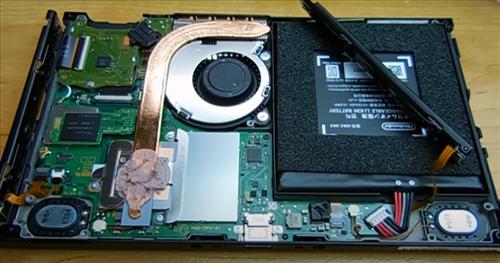The Nintendo Switch frequently experiences problems with the fan not turning on when it should. Frequently, the problem is either a broken joycon rail or a problem with the fan itself.
The fan and joycons of the Nintendo Switch are powered by the same power line. Nintendo thought that it would be a good idea to power both lines from the same MOSFET, which is situated slightly north of M92T36, for whatever reason.
This mosfet occasionally has a 0L (open) failure, which prevents power from reaching the fan and joystick rails. This implies that neither the system nor the joycons may be directly charged from the switch.
Here is our guide on Fix: Nintendo Switch fan not working.
Article Contents
Why does Nintendo Switch fan not working

Short Answer: Nintendo switch fan may not work due to a lot of issues. It may have stopped working as the device maybe getting overheated, or it could be due to dust and debris present that may block the Switch fan to work.
These consoles’ frequent non-working fans are one of their worst flaws. This is one of the Nintendo Switch’s most frequent complaints. Thus, the Nintendo Switch fan not working is rather usual.
When you initially receive your console, it can be loud because of a manufacturing error. This might also happen if your Nintendo Switch was mishandled or mistreated during shipping.
On an earlier Nintendo Switch, the fan noise will get louder and louder if you’re playing demanding games. That is simply due to the hardware’s age, which prevents it from supporting more modern games.
Before attempting any of the solutions we have for you, be sure the noise is coming from a Nintendo Switch fan. Noise may occasionally come from the power supply unit or other parts. You must thus verify that the noise is coming from the cooling fans.
The easiest way to be sure is to follow the direction of the sounds. If it doesn’t reveal the source, what kind of noise is the Nintendo Switch making? If it’s whirring or whooshing, it’s a Nintendo Switch fan.
Electrical noise, such as a buzzing sound, might be coming from the power cord. The fan blades on your Nintendo Switch may be out of alignment and banging against adjacent objects if it sounds more like it is ticking. What you can do if your console begins to sound like a jet engine is listed briefly below.
Fix: Nintendo Switch fan not working
1. Cleaning your Nintendo Switch completely
If the fans are still loud after cleaning the dirty ports, you might want to think about deep cleaning your console. It can look tough to open your Nintendo Switch, but it’s actually much easier than it sounds.
Carefully unplug and turn off your Nintendo Switch first. You may find two Torx T10 screws keeping the lid in place by turning it over. Carefully remove the outer shell after using a Torx T10 screwdriver to remove both screws. Locate and carefully remove the extra five screws that are situated on the device’s top after removing the upper cover.
These are the long screws that connect the bottom shell of the Nintendo Switch to its interior parts. Once the screws have been removed, the machine’s front-facing single ribbon cable may be pulled out. Use tweezers if required. Now, carefully move the console back and away from the bottom cover.
Use your can of compressed air to blow away any dust and debris that may have amassed in the fan and heat sink. It’s conceivable that impediments in these locations on your console are preventing the GPU from dissipating heat properly. The buildup of heat might lead to an overheated Nintendo Switch.
Once the screws have been removed, the machine’s front-facing single ribbon cable may be pulled out. Use tweezers if required. Now, carefully move the console back and away from the bottom cover.
After flipping it over, take out the last few screws. By removing this metal cover, you can now access the fan and heat sink of your Nintendo Switch.
2. Play Switch in a cooler location
Your Nintendo Switch could stop working if the device gets heated up.
One of the simplest remedies for a Nintendo Switch that constantly overheats is to move it to a location that is substantially cooler. Because of the heat buildup, Nintendo Switch fans may be operating more vigorously than necessary, which causes them to be excessively loud for lengthy periods of time.
If your console is kept in a spot in your room that doesn’t receive enough ventilation, this may be the issue.
Simply move the Nintendo Switch to a location in the room that is more conducive to dealing with this. By positioning the fan on top of a table or shelf with sufficient airflow, the noise levels should be significantly decreased.
3. Clean the fan of the Nintendo Switch
One of the simplest methods to get the Nintendo Switch fan operating is to clean the cooling fan. If the console is dusty, the fan has a harder time cooling the CPU. Unfortunately, the fan will have to work harder as more dust enters the console. As a result, maintenance is essential.
We suggest that you clean your cooling fans on a regular basis, especially if your house is messy. You may do that by utilizing a microfiber cloth, compressed air, or an electric duster. The Nintendo Switch’s surface must be cleaned using a microfiber cloth. Drag the cloth in a single direction to avoid forcing dust into the ports and dust grates.
After cleaning the top and sides of the Nintendo Switch, attach the smallest nozzle to the electric or pressured duster. If the air blasts continue for a long time, you run the risk of harming your internal organs. Concentrate on the ports and apertures of the console to get rid of as much dust as you can.
4. Contact Nintendo support
We noticed from reading the discussion that many users seemed to have had experience getting in touch with the Nintendo Support Team.
The staff may ask you a few questions to validate your error before taking the required steps to resolve the underlying issues. They could also assist by sending out technical teams to advise you on how to resolve the fan problem.
Follow us on Twitter & like our Facebook page for more post-updates.
Check out more –

An experienced gaming content writer who emphasizes on offering the most recent information and how-to tutorials for the trending titles. Being a Hardcore gamer himself, he likes to try an array of games and likes to spend his time exploring them. He likes to unwind by listening to R&B music when he’s not writing about gaming stuff.

